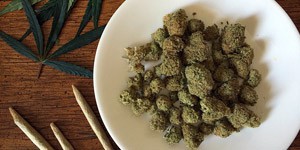By Soraia Tomás

Having earned a degree in Nursing from Escola Superior de Enfermagem de Coimbra in 2015, Soraia Tomás worked in the intensive care unit of cardiothoracic surgery and lung transplantation in Lisbon. In 2020, she obtained a graduate degree in GMPs for Medicinal Cannabis, a course held by the Portuguese Observatory of Medicinal Cannabis in partnership with the Military Laboratory of Chemical and Pharmaceutical Products and the Faculty of Pharmacy of the University of Lisbon. A specialist in Pain Control, she is currently working in an intensive care unit and providing counseling and nursing supervision to patients using Medicinal Cannabis. She is President of APCANNA – the Portuguese Association for Information about Cannabis, a non-profit association, formed in 2020, whose main mission is the dissemination of reliable information about the cannabis plant in all its aspects, being a representative voice of the Portuguese community and its interests.
Cannabidiol (CBD) is the second most common phytocannabinoid present in the cannabis plant and the best-known for its non-intoxicating properties. Its main mechanism of action involves the activation of other neurotransmitter systems (chemical messengers) in the brain, body, and immune system. Thus, this molecule couples with serotonin receptors, vanilloid, and probably dozens of other types of receptors, triggering complex biological responses.
CBD was discovered in 1940 and, to date, around 1300 studies have been carried out, including meta-analyses, human clinical trials, and double-blind, placebo-controlled experiments. Nowadays, we know that its therapeutic potential is vast and that there are more and more reports of its anticonvulsant, anxiolytic, and analgesic properties, among others.
In recent years, the scientific evidence proving the therapeutic potential of cannabis has dramatically increased, leading to legislative reform in several countries regarding its use in medicinal contexts. Theoretically, these regulatory changes would result in greater accessibility of medicines and/or substances based on the cannabis plant, but this improvement is not evident on a practical level in the European context.
Discussion regarding CBD regulation remains open, leading to a lack of uniformity regarding its legality at a European level. While in some countries a patient may go to a pharmacy and buy a CBD-based medicine with a prescription, in neighboring countries it's sold as a food supplement or cosmetic and can be purchased in shops or from the Internet. This regulatory grey zone in which CBD is located, along with growing demand, has led to controversy about how, nowadays, many patients acquire products based on this phytocannabinoid on their own initiative, without medical supervision, and without any control over quality, efficacy, and safety.
Based on this scenario, clearly this document needs to be written. It aims to educate and provide patients and/or consumers with the tools they need to make informed decisions based on knowledge acquired from reliable sources, thus mitigating the risk of acquiring products and/or substances which could put their own health at risk. Therefore, I would like to emphasize that the purpose of this document is not to advise on any type of product, and that you should always consult a physician to learn what best suits your health situation.
What should I know about CBD products?
- Extraction Source
- Extraction Method
- Product Type
- Laboratory Analysis Certificate
- Storage
1. Extraction Source
It is important that you have some information about the source and from which part(s) of the plant the CBD was extracted. You should ask about the cultivation and extraction conditions, knowing that nowadays most companies comply with the quality standards of cultivation and/or extraction required at European level, including the GACP and/or GMP guidelines.
It is also important to know which parts of the plant are used for extraction, bearing in mind that hemp seeds, despite being an excellent source of omega-3 and omega-6, do not contain CBD. You can get this information by reading the product label or checking the company's website.
2. Extraction Methods
Cannabis extraction can be defined as the process of removing or separating essential oils containing several compounds, namely phytocannabinoids, terpenes, vitamins, and other antioxidants from the plant material.
To successfully separate these components from the plant material, methods involving the use of heat/pressure/water (mechanical extraction) or the use of solvents such as propane, butane, ethanol and/or supercritical carbon dioxide (chemical extraction) are required.
2.1 Mechanical Extraction
Mechanical extraction is done through the physical removal of resinous trichomes from the plant by techniques involving heat/pressure/water and their subsequent manipulation to obtain the desired concentrated final product.
2.2 Chemical Extraction
- Ethanol extraction is considered a simple, cheap, and efficient method for the extraction of basic phytocannabinoids. Besides being more sustainable – as in several countries it may be used in several extraction cycles, leading to decreased energy consumption – it's also considered a safe solvent by most regulatory authorities. The fact that it is a highly 'exhaustive' solvent makes this method disadvantageous as it is not selective about the extracted components and can damage their structure.
- Carbon dioxide (CO2) extraction is currently very popular as it is a pure chemical substance that occurs naturally and leaves behind no residues. Besides being non-toxic, it is also frequently used in the food industry, namely in carbonated drinks or to extract caffeine from coffee (decaffeinated). Through temperature and pressure manipulation it is possible to modulate CO2 solubility, allowing individual fractionation of different molecules such as cannabinoids and terpenes. The main drawbacks of this type of extraction are the high maintenance costs and the necessity of a second purification phase following the main supercritical extraction, necessary for the removal of undesired plant matter (fats, lipids, waxes) from the intermediate paste. Both factors contribute to the high price of supercritical CO2 extracts.
- Butane is a common hydrocarbon used for extraction and is a popular choice among manufacturers due to its low cost. Like other solvents, butane is pressurized and separates cannabinoids, terpenes, and other compounds from plant matter. The non-polar nature of the solvent means that it doesn't extract undesirable water-soluble compounds such as chlorophyll and plant metabolites.
- Propane is used similarly to butane. Hydrocarbon extracts have become a source of concern among consumers in recent years due to a lack of enforcement and regulation leading to residual amounts of butane, which is harmful to humans, in marketed products.
Each extraction method has its own advantages and disadvantages and being knowledgeable about them will enable you to select the most appropriate product for your needs. As with any product, you can and should ask the producer for information about the extraction method as well as laboratory test results listing residual solvents. Product prices will differ depending on the extraction method, as some require more complex equipment and well-trained technicians to operate them. Supercritical CO2 extraction is the most expensive for producers (and therefore for you), while other concentrates can be produced using relatively cheap solvents such as ethanol and butane.
3. Product Type
According to the method and solvent used, cannabis extracts can be refined in several forms and concentrations which include:
- Full spectrum: contains the complete phytocannabinoid and terpene plant profile.
- Broad spectrum: Products in which one phytocannabinoid (usually THC) and/or terpene has been removed.
- Isolated: Contains only one phytocannabinoid.
4. Laboratory Analysis Certificate
Cannabis is a bio-accumulator plant, absorbing all substances present in the soil, from nutrients and minerals to heavy metals, pesticides, molds, and bacteria. Whilst it is important that the extraction process is carried out in a controlled environment, meeting the required quality standards, it is also crucial that the same level of tight control is applied to the cultivation phase, thus guaranteeing the final product's quality and safety.
Best practice, wherever possible, is trying to choose a product that has been tested by an independent laboratory. This ensures an impartial analysis, meaning that any product that has gone through the process will have a certificate of analysis (COA). These labs have validated equipment and analysis methods at their disposal to test cannabinoids such as high-performance liquid chromatography (HPLC) and ultra-performance liquid chromatography (UPLC). This method is not the most suitable for terpene analysis – gas chromatography/mass spectrometry (GC/MS) being the most appropriate – but not every laboratory uses this method. You can find the analysis report on most CBD companies' websites or request it via e-mail.
Laboratory tests should therefore contain the following information:
- Phytocannabinoid and terpene content: Any analysis report should indicate the content of CBD as well as other minor cannabinoids. As it is difficult to quantify the exact terpene content by HPLC, most reports only indicate that the product is rich in certain terpene(s). CBD quantity is expressed according to the product form, usually per bottle, milliliter, or capsule. For example, if the label states that the product has 1000 mg of CBD in a 10 ml bottle, this is equivalent to approximately 100mg of CBD per ml. Thus, if there is a 1ml dropper in the bottle (approx. 20 drops per ml), it means that each drop contains 5mg of CBD.
- Contaminants, solvent residues, and heavy metals: Every laboratory should also test and report the presence of pesticides, solvent residues like butane and propane, heavy metals like lead, mercury, and arsenic, and other chemicals toxic to humans.
- Microbiology tests: Here you will learn the amount of mold and other micro-organisms, such as potentially harmful bacteria. Note that these are not visible to the naked eye and can be very harmful to humans, notably aflatoxin, a poison produced by Aspergillus, which is carcinogenic and liver toxic. Pathogenic bacteria commonly detected in cannabis include strains such as Escherichia coli and Staphylococcus, for which reason it is of utmost importance to perform this type of analysis to ensure product quality and safety.
5. Storage
CBD products should be properly stored, as exposure to humid environments or sunlight may cause the degradation of some active ingredients and the growth of molds. Therefore, it is recommended to keep it in a cool and dark place, protected from direct sunlight exposure.
The CBD industry is a growing market, but it is still relatively young. Lack of regulation, legal uncertainties, and insufficient information/education can put the health of the consumer at risk. Currently, most companies strive to guarantee quality throughout the production chain, but this is not the reality for all those currently on the market. Therefore, it is important that the patient and/or consumer is properly informed about all aspects that should be assessed before purchasing any type of product, bearing in mind that, ideally, you should seek medical advice, and obtain any type of medicine and/or substance based on cannabis through legal routes, according to your country's regulations.


